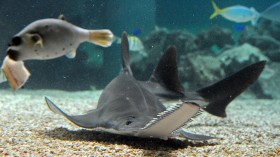Hundreds of millions of years ago, humans have yet to exist. Instead, new research in the journal Nature suggested that the man's earliest known prehistoric ancestor was a tiny "bag-like" organism that lived in the ocean.
According to a report from Live Science, researchers were able to unearth the remains of a 540-million-year-old creature that was dubbed as the Saccorhytus coronaries due to its strange wrinkly appearance. The organism was discovered in China and was classified as a deuterostome, a broad group that encompasses all vertebrates including humans as well as some invertebrates like the starfish. The team of scientists who spearheaded the new study believes they have found the origin of this very wide family.
"We think that as an early deuterostome this may represent the primitive beginnings of a very diverse range of species, including ourselves," University of Cambridge professor of evolutionary palaeobiology Simon Conway Morris said in a statement in the University of Cambridge website. "To the naked eye, the fossils we studied look like tiny black grains, but under the microscope the level of detail is jaw-dropping. All deuterostomes had a common ancestor, and we think that is what we are looking at here."
At face value, the S. coronaries shares very few qualities with the modern human. For one, it's tiny at only around a millimeter long. The ancient creature's mouth is almost comically large, but it doesn't seem to possess an anus, suggesting that waste material may have been ejected through the mouth as well.
Using an electron microscope and a CT scan, the researchers were able to take a closer look at the mysterious organism. Their observations revealed that the S. coronaries had a bilaterally symmetrical body, a feature they passed on to modern descendants like humans. Thin and flexible skin suggests it has muscles that help it move in water and catch food. Conical structures appear to surround its mouth, perhaps even a precursor of gills.
The study was conducted by researchers from the University of Cambridge in the United Kingdom and the Northwest University in Xi'an, China.
© 2024 NatureWorldNews.com All rights reserved. Do not reproduce without permission.
![Severe Thunderstorm Alert: Tornadoes, Damaging Winds and Hail Possible from Upper Ohio Valley to Northeast US [NWS]](https://1471793142.rsc.cdn77.org/data/thumbs/full/70161/280/157/50/40/severe-thunderstorm-alert-tornadoes-damaging-winds-and-hail-possible-from-upper-ohio-valley-to-northeast-us-nws.jpg)




